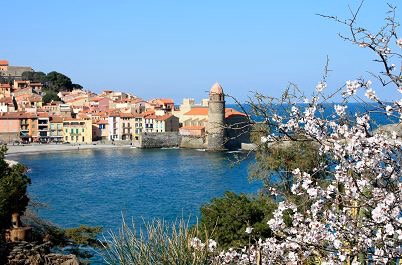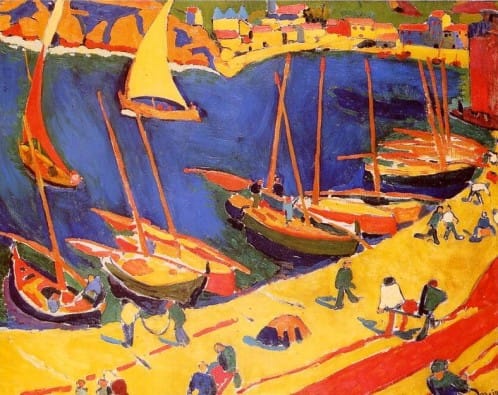Henri Matisse arrived in Collioure in May 1905 at the age of 36, depressed, full of self doubts and very short of money. As soon as he got off the train he was struck by the vitality of the little Catalan fishing port. His depression lifted.

Everywhere he saw colour and light, almost violent in its intensity. He was about to fill a hundred canvasses and start a new movement in the history of art. He sent a simple postcard to his friend Andre Derain. “Venez!” it said.
And Derain came, just in time to celebrate his 25th birthday. Tall and good-looking, when he arrived at the Station Hotel dressed in white, a red beret on his head, La Dame Roussette, la patronne, thought he looked dressed for a carnival. She was not sure she wanted him as a lodger. He swept off his beret and bowed to her. His bags were collected from the station and he set to work.

Later, Derain was to remark that the colours of Collioure that summer of 1905 had been as “sticks of dynamite”. The two artists certainly went into battle together. Their easels often side by side, they painted Collioure from every angle.

…when i put down a green, it doesn’t mean grass; and when I put down a blue, it doesn’t mean the sky” HENRI MATISSE
Matisse’s family were his models. He would set off in the very early morning, particularly for the painting he did of his wife Amelie, nude in a forest clearing, worried lest she be spotted by a wandering Colliourenc. Fortunately in 1905 the woods came right down to the shores of the Mediterranean, making it comparatively easy to find a private glade.
He loved open windows, the scenes they framed were alive with colours that had never been used to such effect before. Red sand, pink sea; he painted what he felt. Derain’s paintings may have been more conventional in that the sand was often yellow but his use of colour was every bit as powerful as that of Matisse… They worked well together.

Derain was a great friend of Vlaminck, and, although he never came to Collioure, it was with Vlaminck that Matisse and Derain so shocked the Paris Art World at the Salon d’Automne of 1905. Derain described their work as a “trial by fire”, a purifying of painting, a liberating of colour. The critics described it as the work “fauves”, of “wild beasts”. It was not a compliment. But the name stuck, Fauvism was born and Matisse was head “Fauve”.
In 1994 “Le Chemin du Fauvisme” was first set up, a guided walk with strategically placed copies of the paintings of Derain and Matisse in the positions in which they were painted. It allows a fascinating insight into the storm of colour and excitement that exploded in Collioure that distant summer of 1905.

With a knowledgeable guide, the works of Matisse and Derain come alive. Matisse bursts like fireworks across the canvass, and we see how Derain, a keen amateur photographer, used the line of the balcony itself to draw the eye to the church and the famous Clocher. We are led through the narrow alleys, up to the top of the town where again they painted side by side, the same view, different pictures. We follow their footsteps, understand their emotion, see the Collioure they saw and painted.


[…] not occasional: one day Matisse and Derain came here to switch off from the hustle of capital Paris, and as a result created the new art style […]